Decoding Fear: Analysis and Prognosis of Preoperatory Stress Level Through Advanced Statistical Modelling—A Prospective Study Across Multiple Surgical Specialties †
Abstract
1. Introduction
1.1. Preoperative Anxiety
1.2. Factors Influencing Preoperative Stress
1.3. Scales for Measuring Preoperative Stress
2. Material and Methods
2.1. Participant Selection and Measures
2.2. Ethical Considerations
2.3. Statistical Analysis
3. Results
3.1. Demographic and Clinical Characteristics
3.2. Results of the B-MEPS Questionnaire
3.2.1. Items 1–4 (Immediate Emotional Symptoms)
3.2.2. Items 5–8 (Persistent Emotional Reactions)
3.2.3. Items 9–10 (Simple Emotional and Somatic States)
3.2.4. Items 11–12 (Depressive Profile)
3.3. Overall Preoperative Stress Score
3.3.1. Preoperative Stress Level by Demographic Data
3.3.2. Preoperative Stress Level by Medical History
3.3.3. Preoperative Stress Level by Type of Surgical Intervention
3.4. Identification of Predictive Factors for Preoperative Stress
4. Discussion
4.1. Influence of Sex on Preoperative Stress
4.2. Influence of Educational Level on Preoperative Stress
4.3. Influence of Marital Status on Preoperative Stress
4.4. Influence of Cancer Diagnosis on Preoperative Stress
4.5. Influence of Surgical Procedure Type on Preoperative Stress
4.6. Identification of Predictors of Preoperative Stress
4.7. Study Limitations
5. Conclusions
Author Contributions
Funding
Institutional Review Board Statement
Informed Consent Statement
Data Availability Statement
Conflicts of Interest
References
- Rakesh, A.; Nag, A.; Milton, B.; Arun, A. Evaluation of Preoperative and Postoperative Anxiety Levels among Surgical Patients in a Tertiary Care Hospital. Int. Neuropsychiatr. Dis. J. 2024, 21, 155–162. [Google Scholar] [CrossRef]
- Parveen, S.; Khan, N.A.; Waseem, H.F.; Bakhsh, M.M.; Aziz, A. Frequency of Anxiety in Pre-Operative Surgical Patients in the Tertiary Care Hospitals, Karachi. J. Health Rehabil. Res. 2024, 4, 1587–1596. [Google Scholar] [CrossRef]
- Caumo, W.; Nazare Furtado da Cunha, M.; Camey, S.; Maris de Jezus Castro, S.; Torres, I.L.S.; Cadore Stefani, L. Development, Psychometric Evaluation and Validation of a Brief Measure of Emotional Preoperative Stress (B-MEPS) to Predict Moderate to Intense Postoperative Acute Pain. Br. J. Anaesth. 2016, 117, 642–649. [Google Scholar] [CrossRef]
- Caumo, W.; Schmidt, A.P.; Schneider, C.N.; Bergmann, J.; Iwamoto, C.W.; Bandeira, D.; Ferreira, M.B. Risk Factors for Preoperative Anxiety in Adults. Acta Anaesthesiol. Scand. 2001, 45, 298–307. [Google Scholar] [CrossRef]
- Turliuc, D.; Turliuc, S.; Cucu, A.; Buraga, V.; Costea, C.F. Claiming Dignity While Dangling between Life and Death. Rom. J. Artist. Creat. 2015, 1, 34–38. [Google Scholar]
- Gursoy, A. The Effect of Pre-Operative Distress on the Perioperative Period. J. Anesth. Inten. Care Med. 2017, 2, ID 555588. [Google Scholar] [CrossRef]
- Bansal, T.; Joon, A. Preoperative Anxiety-an Important but Neglected Issue: A Narrative Review. Indian Anaesth. Forum 2016, 17, 37. [Google Scholar] [CrossRef]
- Wahyudi, W.; Fitriati, M.; Airlangga, P.S.; Semedi, B.P. Preoperative Anxiety and Plasma Adrenaline Levels Changes in Caesarean Section with Spinal Anesthesia: A Literature Review. Bali Med. J. 2024, 13, 1002–1008. [Google Scholar] [CrossRef]
- Friedrich, S.; Reis, S.; Meybohm, P.; Kranke, P. Preoperative Anxiety. Curr. Opin. Anaesthesiol. 2022, 35, 674–678. [Google Scholar] [CrossRef] [PubMed]
- Ahmetovic-Djug, J.; Hasukic, S.; Djug, H.; Hasukic, B.; Jahic, A. Impact of Preoperative Anxiety in Patients on Hemodynamic Changes and a Dose of Anesthetic During Induction of Anesthesia. Med. Arch. 2017, 71, 330–333. [Google Scholar] [CrossRef] [PubMed]
- Tolksdorf, W. Preoperative stress. Research approach and methods of treatment. Anasthesiol. Intensivmed. Notfallmedizin Schmerzther. 1997, 32, S318–S324. [Google Scholar] [CrossRef]
- Tolksdorf, W.; Berlin, J.; Rey, E.R.; Schmidt, R.; Kollmeier, W.; Storz, W.; Ridder, T.; Schaetzle, P. Preoperative stress. Study of the mental behavior and parameters of physiological stress in non-premedicated patients during the preoperative period. Anaesthesist 1984, 33, 212–217. [Google Scholar]
- Ivascu, R.; Torsin, L.I.; Hostiuc, L.; Nitipir, C.; Corneci, D.; Dutu, M. The Surgical Stress Response and Anesthesia: A Narrative Review. J. Clin. Med. 2024, 13, 3017. [Google Scholar] [CrossRef]
- Kassahun, W.T.; Mehdorn, M.; Wagner, T.C.; Babel, J.; Danker, H.; Gockel, I. The Effect of Preoperative Patient-Reported Anxiety on Morbidity and Mortality Outcomes in Patients Undergoing Major General Surgery. Sci. Rep. 2022, 12, 6312. [Google Scholar] [CrossRef]
- Geoffrion, R.; Koenig, N.A.; Zheng, M.; Sinclair, N.; Brotto, L.A.; Lee, T.; Larouche, M. Preoperative Depression and Anxiety Impact on Inpatient Surgery Outcomes: A Prospective Cohort Study. Ann. Surg. Open 2021, 2, e049. [Google Scholar] [CrossRef]
- Cucu, A.I.; Turliuc, Ş.; Sandiuc, M.C.; Dascălu, C.G.; Boişteanu, O.; Bobu, A.M.; Costea, C.F.; Prutianu, I.; Cărăuleanu, A.; Buzdugă, C.M.; et al. Facing the Knife, Finding the Spirit? A Study of Daily Spiritual Experiences Scale (DSES) Scores in Romanian Surgical and Non-Surgical Patients. Healthcare 2025, 13, 1820. [Google Scholar] [CrossRef] [PubMed]
- Jovanović, K.; Kalezić, N.; Šipetić-Grujičić, S. Preoperative Anxiety: An Important, but Neglected Issue. Med. Istraž. 2022, 55, 53–58. [Google Scholar] [CrossRef]
- Rätsep, T.; Kams, L. Preoperative Anxiety Predicts Dissatisfaction with the Results of Lumbar Intervertebral Discectomy. Orthop. Res. Online J. 2022, 9, 949–954. [Google Scholar] [CrossRef]
- Mukhlis, M.; Ayatullah, A.; Kadafi, A. Analisis Faktor Yang Mempengaruhi Tingkat Kecemasan Pasien Pre Operasi Di Rumah Sakit. Umum Daerah Kabupaten Dompu Tahun 2023. Barongko J. Ilmu Kesehat. 2024, 2, 461–478. [Google Scholar] [CrossRef]
- Asadpour Sorkhkolaee, H.; Mokarrami Rostami, M.; Pahnabi, A. Investigation of Stress-Inducing Factors and Preoperative Anxiety and Their Mitigation Strategies from Patients’ Perspectives in Surgical Departments of Educational Medical Centers at Mazandaran University of Medical Sciences in 2023. Tabari Biomed. Stud. Res. J. 2023, 5, 25–32. [Google Scholar] [CrossRef]
- Aust, H.; Borgert, A.; Vogelsang, V.; Zoremba, M.; Höltermann, W. Anaesthesiological experience and factoid public information—Effects, interactions and possible strategies for perioperative stress reduction. Z. Geburtshilfe Neonatol. 2011, 215, 29–34. [Google Scholar] [CrossRef]
- Pappas, M.A.; Sessler, D.I.; Auerbach, A.D.; Kattan, M.W.; Milinovich, A.; Blackstone, E.H.; Rothberg, M.B. Variation in Preoperative Stress Testing by Patient, Physician and Surgical Type: A Cohort Study. BMJ Open 2021, 11, e048052. [Google Scholar] [CrossRef]
- Fu, W.-H.; Hu, Z.-L.; Liao, Y.-J.; Chen, R.-J.; Qiu, J.-B.; Que, W.-T.; Wang, W.-T.; Li, W.-H.; Lan, W.-B. Relationship between Preoperative Psychological Stress and Short-Term Prognosis in Elderly Patients with Femoral Neck Fracture. World J. Psychiatry 2024, 14, 838–847. [Google Scholar] [CrossRef]
- Buivydienė, A.; Jakavonytė-Akstinienė, A. Patients’ Anxiety and Its Causes in the Pre-Operative Period. Slauga Moksl. Prakt. 2023, 4, 17–24. [Google Scholar] [CrossRef]
- Mat Nawi, M.A.; Mulud, Z.A.; Mohamad, N. Empowerment and Preoperative Anxiety among Patients Undergoing Cardiac Surgery: A Cross Sectional Study. Malays. J. Med. Health Sci. 2023, 19, 28–35. [Google Scholar] [CrossRef]
- Tam, A.; Bateman, S.; Buckingham, G.; Wilson, M.; Melendez-Torres, G.J.; Vine, S.; Clark, J. The Effects of Stress on Surgical Performance: A Systematic Review. Surg. Endosc. 2025, 39, 77–98. [Google Scholar] [CrossRef] [PubMed]
- Amalan, S.; Vaishali, B.; Joseph, J.; Sivaprakasam, M. Pre-Surgery Stress Monitoring Using Heart Rate Variability Measures. Annu. Int. Conf. IEEE Eng. Med. Biol. Soc. 2019, 2019, 4592–4595. [Google Scholar] [CrossRef] [PubMed]
- Anusha, A.S.; Sukumaran, P.; Sarveswaran, V.; Surees Kumar, S.; Shyam, A.; Tony, J.A.; Preejith, S.P. Electrodermal Activity Based Pre-Surgery Stress Detection Using a Wrist Wearable. IEEE J. Biomed. Health Inform. 2020, 24, 92–100. [Google Scholar] [CrossRef]
- The State-Trait Anxiety Inventory (STAI). Available online: https://www.apa.org/pi/about/publications/caregivers/practice-settings/assessment/tools/trait-state (accessed on 9 August 2025).
- Wolmeister, A.S.; Schiavo, C.L.; Nazário, K.C.K.; Castro, S.M.D.J.; de Souza, A.; Caetani, R.P.; Caumo, W.; Stefani, L.C. The Brief Measure of Emotional Preoperative Stress (B-MEPS) as a New Predictive Tool for Postoperative Pain: A Prospective Observational Cohort Study. PLoS ONE 2020, 15, e0227441. [Google Scholar] [CrossRef]
- Moerman, N.; van Dam, F.S.; Muller, M.J.; Oosting, H. The Amsterdam Preoperative Anxiety and Information Scale (APAIS). Anesth. Analg. 1996, 82, 445–451. [Google Scholar] [CrossRef]
- Zigmond, A.S.; Snaith, R.P. The Hospital Anxiety and Depression Scale. Acta Psychiatr. Scand. 1983, 67, 361–370. [Google Scholar] [CrossRef]
- Schneider, M.M.; Nietschke, R.; Burkhart, K.J.; Hollinger, B.; Marquardt, J.; Schöttker-Königer, T.; Morrison, F.; Zimmerer, A.; Papen, A. Translation of the Mayo Elbow Performance Score (MEPS) into German (MEPS-G). Z. Orthop. Unfall 2020, 158, 455–461. [Google Scholar] [CrossRef]
- Grover, S.; Laxmi, R. A Systematic Compilation of Rating Scales Developed, Translated, and Adapted in India. Indian J. Psychiatry 2024, 66, 767–787. [Google Scholar] [CrossRef] [PubMed]
- Schiavo, C.L.; Borges, R.B.; Castro, S.M.J.; Wolmeister, A.S.; de Souza, A.; Martins, O.R.S.; Galvão, G.S.; Nazario, K.C.K.; Nickel, F.J.; Caumo, W.; et al. Measuring Emotional Preoperative Stress by an App Approach and Its Applicability to Predict Postoperative Pain. PLoS ONE 2022, 17, e0263275. [Google Scholar] [CrossRef] [PubMed]
- Boker, A.; Brownell, L.; Donen, N. The Amsterdam Preoperative Anxiety and Information Scale Provides a Simple and Reliable Measure of Preoperative Anxiety. Can. J. Anesth. 2002, 49, 792–798. [Google Scholar] [CrossRef]
- Ray, C.; Fitzgibbon, G. Stress Arousal and Coping with Surgery. Psychol. Med. 1981, 11, 741–746. [Google Scholar] [CrossRef]
- Salzmann, S.; Rienmüller, S.; Kampmann, S.; Euteneuer, F.; Rüsch, D. Preoperative Anxiety and Its Association with Patients’ Desire for Support—An Observational Study in Adults. BMC Anesthesiol. 2021, 21, 149. [Google Scholar] [CrossRef]
- Ossai, E.N.; Nwosu, A.D.G.; Onwuasoigwe, O.; Ubboe, K.; Ameh, J.; Alu, L. Prevalence and Predictors of Anxiety among Surgical Patients in the Preoperative Holding Area of National Orthopaedic Hospital, Enugu, Nigeria: A Cross-Sectional Study. J. West Afr. Coll. Surg. 2023, 13, 105–112. [Google Scholar] [CrossRef]
- Dibabu, A.M.; Ketema, T.G.; Beyene, M.M.; Belachew, D.Z.; Abocherugn, H.G.; Mohammed, A.S. Preoperative Anxiety and Associated Factors among Women Admitted for Elective Obstetric and Gynecologic Surgery in Public Hospitals, Southern Ethiopia: A Cross-Sectional Study. BMC Psychiatry 2023, 23, 728. [Google Scholar] [CrossRef] [PubMed]
- Muralikrishna, T.; Sivasankar, P.R.; Narayana, R.; Rachel, L.V. Assessment of Pre-Surgical Depression, Anxiety, and Stress Levels in Patients Undergoing Surgical Procedures in the General Surgery Department. Asian Pac. J. Health Sci. 2021, 8, 101–103. [Google Scholar] [CrossRef]
- Oh, J.; Lee, W.; Ki, S.; Suh, J.; Hwang, S.; Lee, J. Assessment of Preoperative Anxiety and Influencing Factors in Patients Undergoing Elective Surgery: An Observational Cross-Sectional Study. Medicina 2024, 60, 403. [Google Scholar] [CrossRef]
- Ebrahimi, A.; Eslami, J.; Darvishi, I.; Momeni, K.; Akbarzadeh, M. An Overview of the Comparison of Inhalation Aromatherapy on Emotional Distress of Female and Male Patients in Preoperative Period. J. Complement. Integr. Med. 2021, 19, 111–119. [Google Scholar] [CrossRef] [PubMed]
- Masood, Z.; Haider, J.; Jawaid, M.; Alam, S.N. Preoperative anxiety in female patients: The issue needs to be addressed. Khyber Med. Univ. J. 2009, 1, 38–41. [Google Scholar]
- Esplendori, G.F.; Kobayashi, R.M.; Bianchi, E.R.F. Stress and coping strategies of women in preoperative period of valve surgery. J. Nurs. UFPE 2016, 10, 3537–3547. [Google Scholar] [CrossRef]
- Khalili, N.; Karvandian, K.; Ardebili, H.E.; Eftekhar, N.; Nabavian, O. Predictive Factors of Preoperative Anxiety in the Anesthesia Clinic: A Survey of 231 Surgical Candidates. Arch. Anesthesiol. Crit. Care 2019, 5, 122–127. [Google Scholar] [CrossRef]
- Jarmoszewicz, K.; Nowicka-Sauer, K.; Zemła, A.; Beta, S. Factors Associated with High Preoperative Anxiety: Results from Cluster Analysis. World J. Surg. 2020, 44, 2162–2169. [Google Scholar] [CrossRef]
- Kuzminskaitė, V.; Kaklauskaitė, J.; Petkevičiūtė, J. Incidence and Features of Preoperative Anxiety in Patients Undergoing Elective Non-Cardiac Surgery. Acta Med. Litu. 2019, 26, 93–100. [Google Scholar] [CrossRef] [PubMed]
- Anishchenko, T.G.; Igosheva, N.B. Sex differences in response to stress in conscious and anesthesized rats during surgical stress. Biull Eksp. Biol. Med. 1992, 113, 26–28. [Google Scholar] [CrossRef]
- Jones, B.A.; Pisu, M.; Smith, B.; Schoenberger, Y.-M.; Wang, L.; Ivankova, N.V.; Richman, J.; Chu, D.I. Patient Perspectives of the Quality of Preoperative Education in Surgical Cancer Care. JCO Oncol. Pract. 2023, 19, 207. [Google Scholar] [CrossRef]
- Okediji, A.A.; Ating, B.O.; Afolabi, O.A. The Roles of Educational Attainment and Type of Illness on Pre-Surgery (State) Anxiety. IFE Psychol. An. Int. J. 2009, 17, 271–284. [Google Scholar] [CrossRef]
- Hartanti, R.W.; Handayani, L. Pre-operative education to reduce anxiety: Literature review. Epidemiol. Soc. Heal. Rev. 2021, 3, 23–30. [Google Scholar] [CrossRef]
- Ambrose, K.R.; Atzeni, F. Chapter 8—The Relevance of Preoperative Education Among Healthcare Providers, Family Caregivers, and Patients with Systemic Rheumatic Diseases. In Handbook of Systemic Autoimmune Diseases; Atzeni, F., Masala, I.F., Aletaha, D., Lee, M., Baraliakos, X., Eds.; Surgery in Rheumatic and Musculoskeletal Disease; Elsevier: Amsterdam, The Netherlands, 2018; Volume 15, pp. 183–203. [Google Scholar]
- Gil, V.J.C.G.; Trujillo, L.M.M.; Gonzales, P.A.C.; Gasca, E.J.D.; Casagua, M.S.G. Preoperative Anxiety in Patients Scheduled for Minimally Invasive Abdominal Surgery: Institutional Experience. South East. Eur. J. Public Health 2024, 562–570. [Google Scholar] [CrossRef]
- Doñate Marín, M.; Litago Cortes, A.; Monge Sanz, Y.; Martinez Serrano, R. Aspectos de La Información Preoperatoria Relacionada Con La Ansiedad Del Paciente Programado Para Cirugía. Eglobal 2015, 14, 170–191. [Google Scholar] [CrossRef][Green Version]
- Maurício, S.; Rebêlo, I.; Madeira, C.; Resende, F.; Esteves, S. Validation of the Portuguese Version of Amsterdam Preoperative Anxiety and Information Scale (APAIS). Health Qual. Life Outcomes 2021, 19, 95. [Google Scholar] [CrossRef] [PubMed]
- Ta, V.P.; Gesselman, A.N.; Perry, B.L.; Fisher, H.E.; Garcia, J.R. Stress of Singlehood: Marital Status, Domain-Specific Stress, and Anxiety in a National U.S. Sample. J. Soc. Clin. Psychol. 2017, 36, 461–485. [Google Scholar] [CrossRef]
- Wahyuni, W. Dukungan Keluarga Berpengaruh Terhadap Tingkat Kecemasan Pada Pasien Pre Operasi: Family Support Influences Preoperative Patient Anxiety Levels. J. Nurs. Educ. Pract. 2022, 2, 1–8. [Google Scholar] [CrossRef]
- Lau, H.C.; Abohashem, S.; AbiKaram, K.; Civieri, G.; Assefa, A.; Hanlon, E.; Qamar, I.; Khalil, M.; Aldosoky, W.; Seligowski, A.; et al. Abstract 4125025: Association between Marital Status and Major Adverse Cardiovascular Events: Role of Stress-Related Neural-Immune Mechanisms. Circulation 2024, 150, A4125025. [Google Scholar] [CrossRef]
- Ma, Z.; Yuan, Q.; Liu, M.; Tang, Z.; Shang, P.; Yue, J. Marital Status and Accidental Mortality in Male and Female Patients with Cancer: Results from the Population-Based Cohort Study. BMC Public Health 2025, 25, 2251. [Google Scholar] [CrossRef]
- Harsha, S.S.; Kirubamani, H. Preoperative Anxiety Assessment among Women Undergoing Surgery in Department of OBG of Saveetha Medical College and Hospital. Indian J. Obstet. Gynecol. Res. 2025, 6, 504–508. [Google Scholar] [CrossRef]
- Hamermesh, D.S.; Myck, M.; Oczkowska, M. Widows? Time, Time Stress and Happiness: Adjusting to Loss; IZA–Institute of Labor Economics: Bonn, Germany, 2021. [Google Scholar]
- Brown, S.L.; Nesse, R.M.; House, J.S.; Utz, R.L. Religion and Emotional Compensation: Results from a Prospective Study of Widowhood. Pers. Soc. Psychol. Bull. 2004, 30, 1165–1174. [Google Scholar] [CrossRef]
- Carr, D.; House, J.S.; Kessler, R.C.; Nesse, R.M.; Sonnega, J.; Wortman, C. Marital Quality and Psychological Adjustment to Widowhood among Older Adults: A Longitudinal Analysis. J. Gerontol. B Psychol. Sci. Soc. Sci. 2000, 55, S197–S207. [Google Scholar] [CrossRef]
- Mishra, S.; Sarma, R.; Bhan, S.; Vig, S.; Kumar, S.; Satapathy, S.; Sood, M.; Deo, S.V.S.; Bhatnagar, S. Prevalence and Psychosocial Factors Affecting Preoperative Anxiety, Depression, and Stress in Cancer Patients: A Prospective Cross-Sectional Study. Indian J. Cancer 2024, 61, 558. [Google Scholar] [CrossRef]
- Marinelli, V.; Mazzi, M.A.; Rimondini, M.; Danzi, O.P.; Bonamini, D.; Bassi, C.; Salvia, R.; Del Piccolo, L. Preoperative Anxiety in Patients with Pancreatic Cancer: What Contributes to Anxiety Levels in Patients Waiting for Surgical Intervention. Healthcare 2023, 11, 2039. [Google Scholar] [CrossRef] [PubMed]
- Ismail, H.; Baldini, G.; Bergdahl, C.S.; Carli, F. 15–Functional Assessment and Prehabilitation. In Perioperative Care of the Cancer Patient; Hagberg, C., Gottumukkala, V., Riedel, B., Nates, J., Buggy, D., Eds.; Elsevier: New Delhi, India, 2023; pp. 171–184. ISBN 978-0-323-69584-8. [Google Scholar]
- Matzner, P.; Sorski, L.; Haldar, R.; Shaashua, L.; Benbenishty, A.; Lavon, H.; Azan, Y.; Sandbank, E.; Melamed, R.; Rosenne, E.; et al. Deleterious Synergistic Effects of Distress and Surgery on Cancer Metastasis: Abolishment through an Integrated Perioperative Immune-Stimulating Stress-Inflammatory-Reducing Intervention. Brain Behav. Immun. 2019, 80, 170–178. [Google Scholar] [CrossRef] [PubMed]
- Yang, D.-S.; Jeon, Y.D.; Kim, C.-R.; Kim, S.-G.; Park, K.-B. Severe Preoperative Pain, Functional Decline, and High Anxiety Levels Hinder the Efficacy of Multidisciplinary Interventions in Patients Who Underwent Primary Total Knee Arthroplasty. J. Orthop. Surg. Res. 2025, 20, 183. [Google Scholar] [CrossRef]
- Richey, A.E.; Segovia, N.; Hastings, K.; Klemt, C.; Pun, S.Y. Self-Reported Preoperative Anxiety and Depression Associated with Worse Patient-Reported Outcomes for Periacetabular Osteotomy and Hip Arthroscopy Surgery. J. Hip Preserv. Surg. 2024, 11, 251–256. [Google Scholar] [CrossRef] [PubMed]
- Napora, J.; Gryglewski, K.; Piotrowicz, M.; Lebiedź, P.; Mazurek, T.; Nowicka-Sauer, K. Factors Associated with Preoperative Anxiety in Patients Undergoing Ambulatory Hand Surgery: A Cross-Sectional Observational Study. J. Clin. Med. 2024, 13, 7004. [Google Scholar] [CrossRef]
- do Amaral, G.T.; Fernandes, P.A.; de Oliveira Maier, S.R.; Rodrigues, J.P.F.; Dessotte, C.A.M. Perceived stress of patients in the preoperative period of cardiac surgeries/Estresse percebido de pacientes no pré-operatório de cirurgias cardíacas. Rev. Pesqui. Cuid. Fundam. Online 2023, 15, e12054. [Google Scholar] [CrossRef]
- Nakagoshi, N.; Locatelli, F.M.; Kitamura, S.; Hirota, S.; Kawano, T. The Impact of Preoperative Stress on Age-Related Cognitive Dysfunction after Abdominal Surgery: A Study Using a Rat Model. BMC Res. Notes 2024, 17, 369. [Google Scholar] [CrossRef]
- Di Luzio, R.; Dusi, R.; Mazzotti, A.; Petroni, M.L.; Marchesini, G.; Bianchi, G. Stress Hyperglycemia and Complications Following Traumatic Injuries in Individuals With/Without Diabetes: The Case of Orthopedic Surgery. Diabetes Metab. Syndr. Obes. 2020, 13, 9–17. [Google Scholar] [CrossRef]
- Khan, I.A.; Baker, C.M.; Magnuson, J.A.; Courtney, P.M.; Krueger, C.A.; Lonner, J.H. Surgeons Experience More Physiologic Stress and Strain During Revision Than Primary Total Joint Arthroplasty. J. Arthroplast. 2023, 38, 1126–1130. [Google Scholar] [CrossRef] [PubMed]
- Binar, M.; Asik, M.; Genç, H. The Assessment of Morning Anxiety before Different Otorhinolaryngological Surgical Procedures. Prax. Otorhinolaryngol. 2018, 6, 66–71. [Google Scholar] [CrossRef]
- Duymus, M.; Urfali, S.; Ugur, M.; Dal, M.; Donmez, Y.; Bag, Y.; Temiz, M. Evaluation of Preoperative Anxiety in Cancer Patients: Experience of a Single Center. Med. Sci. 2022, 11, 1452. [Google Scholar] [CrossRef]
- Ghanbari, N.; Narimani, M. Psychological Distress in Candidates for Surgery: A Comparative Study Between Patients with Chronic and Acute Diseases. Basic Clin. Cancer Res. 2021, 11, 182–187. [Google Scholar] [CrossRef]
- Oteri, V.; Martinelli, A.; Crivellaro, E.; Gigli, F. The Impact of Preoperative Anxiety on Patients Undergoing Brain Surgery: A Systematic Review. Neurosurg. Rev. 2021, 44, 3047–3057. [Google Scholar] [CrossRef]
- Laufenberg-Feldmann, R.; Kappis, B.; Cámara, R.J.A.; Ferner, M. Anxiety and Its Predictive Value for Pain and Regular Analgesic Intake after Lumbar Disc Surgery—A Prospective Observational Longitudinal Study. BMC Psychiatry 2018, 18, 82. [Google Scholar] [CrossRef]
- Xing, A.; Hengudomsub, P.; Ponpinij, P. Factors Predicting Preoperative Anxiety among Adult Patients Undergoing Cardiac Surgery in China: A Cross-Sectional Study. Belitung Nurs. J. 2025, 11, 163–171. [Google Scholar] [CrossRef]
- Nigussie, S.; Belachew, T.; Wolancho, W. Predictors of Preoperative Anxiety among Surgical Patients in Jimma University Specialized Teaching Hospital, South Western Ethiopia. BMC Surg. 2014, 14, 67. [Google Scholar] [CrossRef]
- Woldegerima Berhe, Y.; Belayneh Melkie, T.; Fitiwi Lema, G.; Getnet, M.; Chekol, W.B. The Overlooked Problem among Surgical Patients: Preoperative Anxiety at Ethiopian University Hospital. Front. Med. 2022, 9, 912743. [Google Scholar] [CrossRef]
- Williams, H.; Jajja, M.R.; Baer, W.; Balch, G.C.; Maithel, S.K.; Patel, A.D.; Patel, D.; Patel, S.G.; Stetler, J.L.; Winer, J.H.; et al. Perioperative Anxiety and Depression in Patients Undergoing Abdominal Surgery for Benign or Malignant Disease. J. Surg. Oncol. 2019, 120, 389–396. [Google Scholar] [CrossRef]
- Woldegerima, Y.B.; Fitwi, G.L.; Yimer, H.T.; Hailekiros, A.G. Prevalence and Factors Associated with Preoperative Anxiety among Elective Surgical Patients at University of Gondar Hospital. Gondar, Northwest Ethiopia, 2017. A Cross-Sectional Study. Int. J. Surg. Open 2018, 10, 21–29. [Google Scholar] [CrossRef]
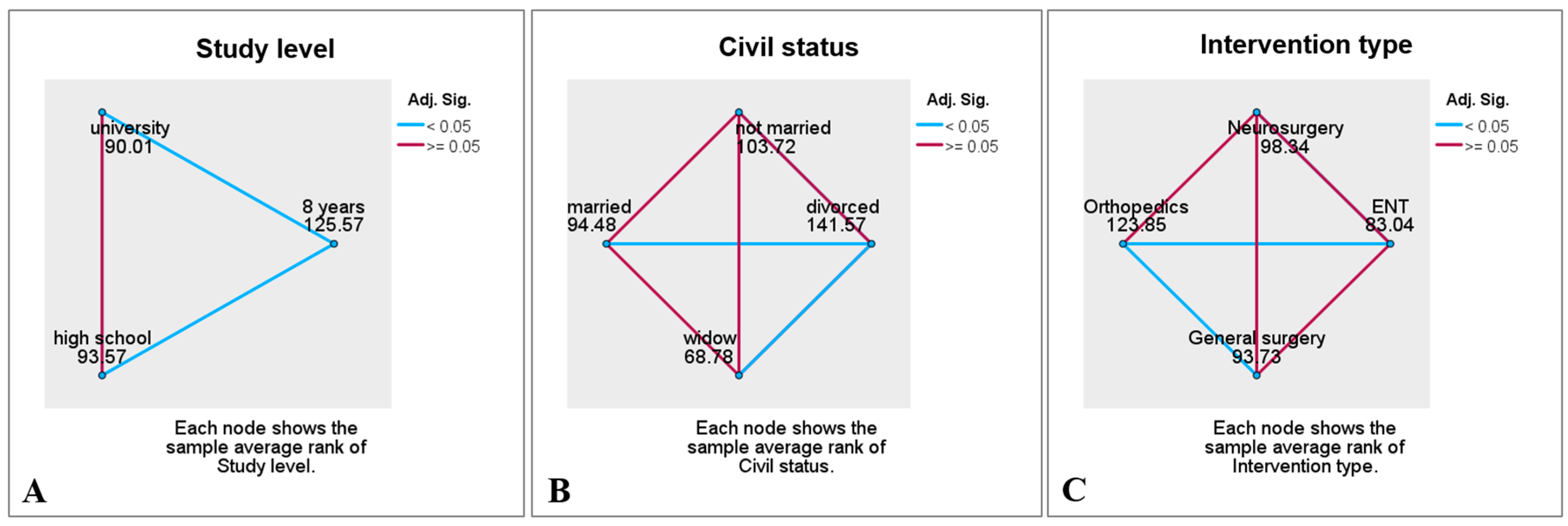
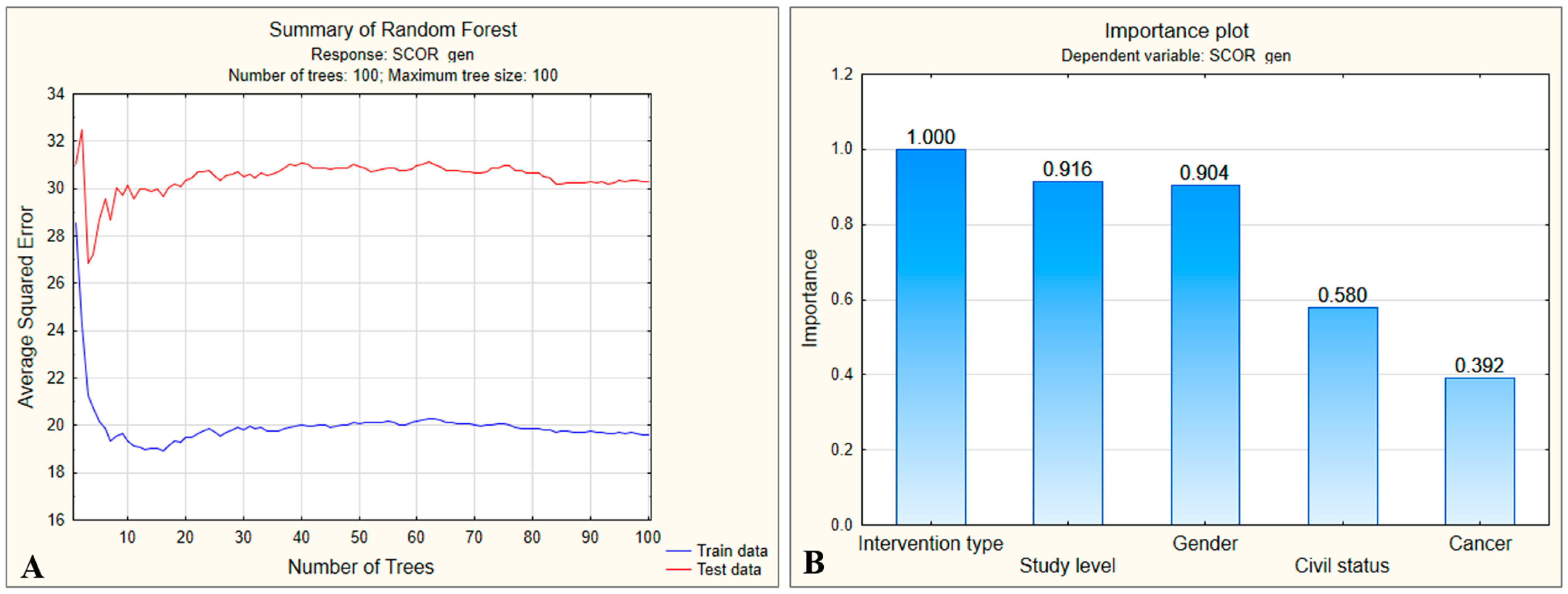

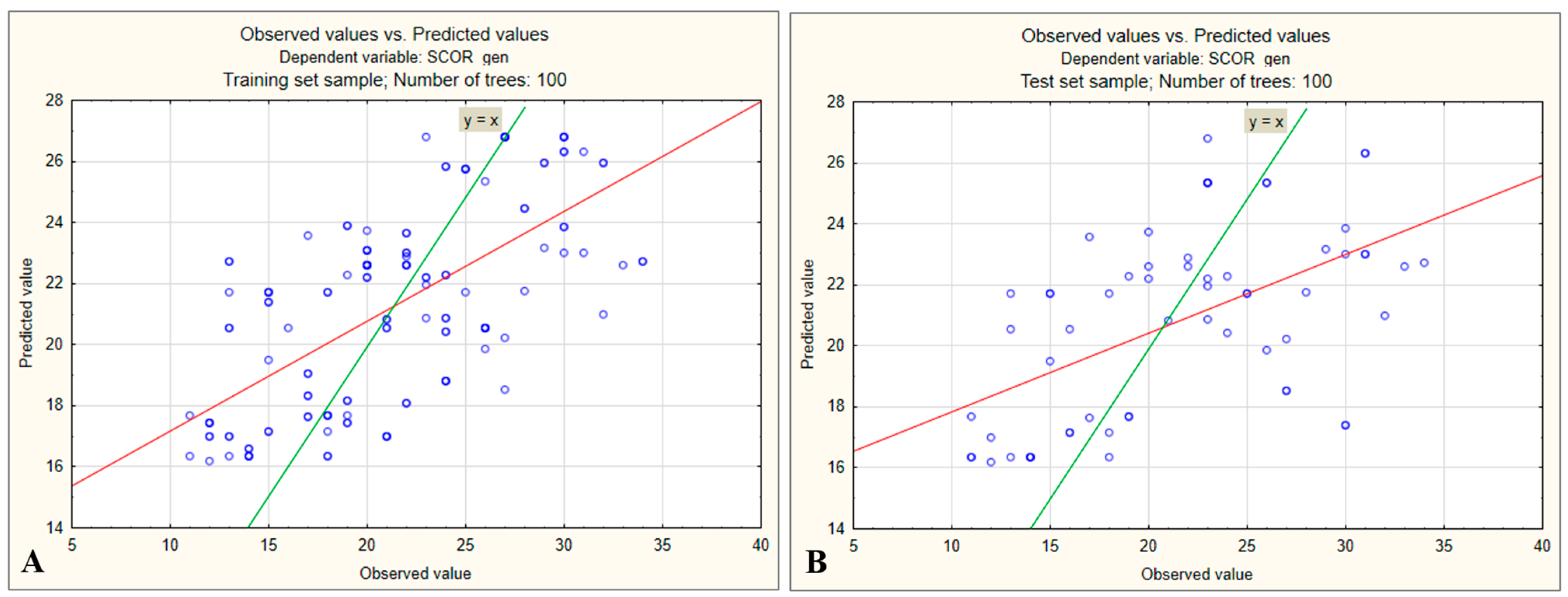
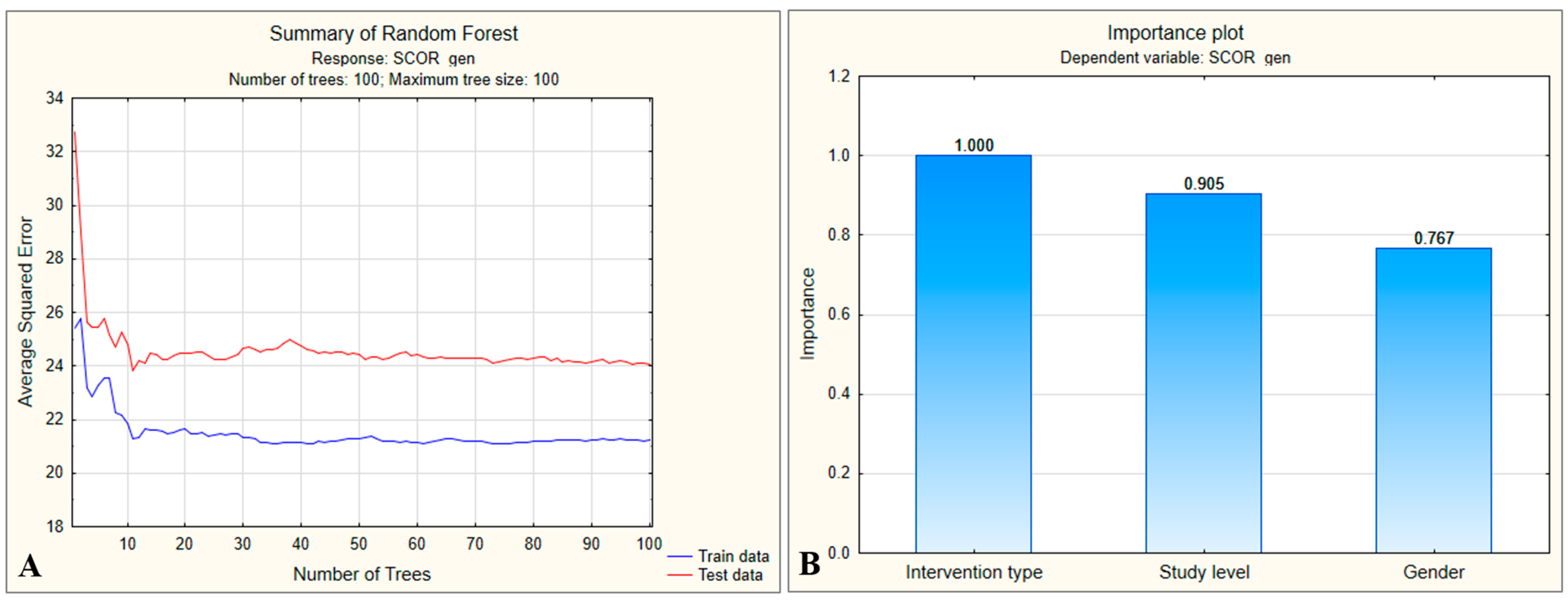
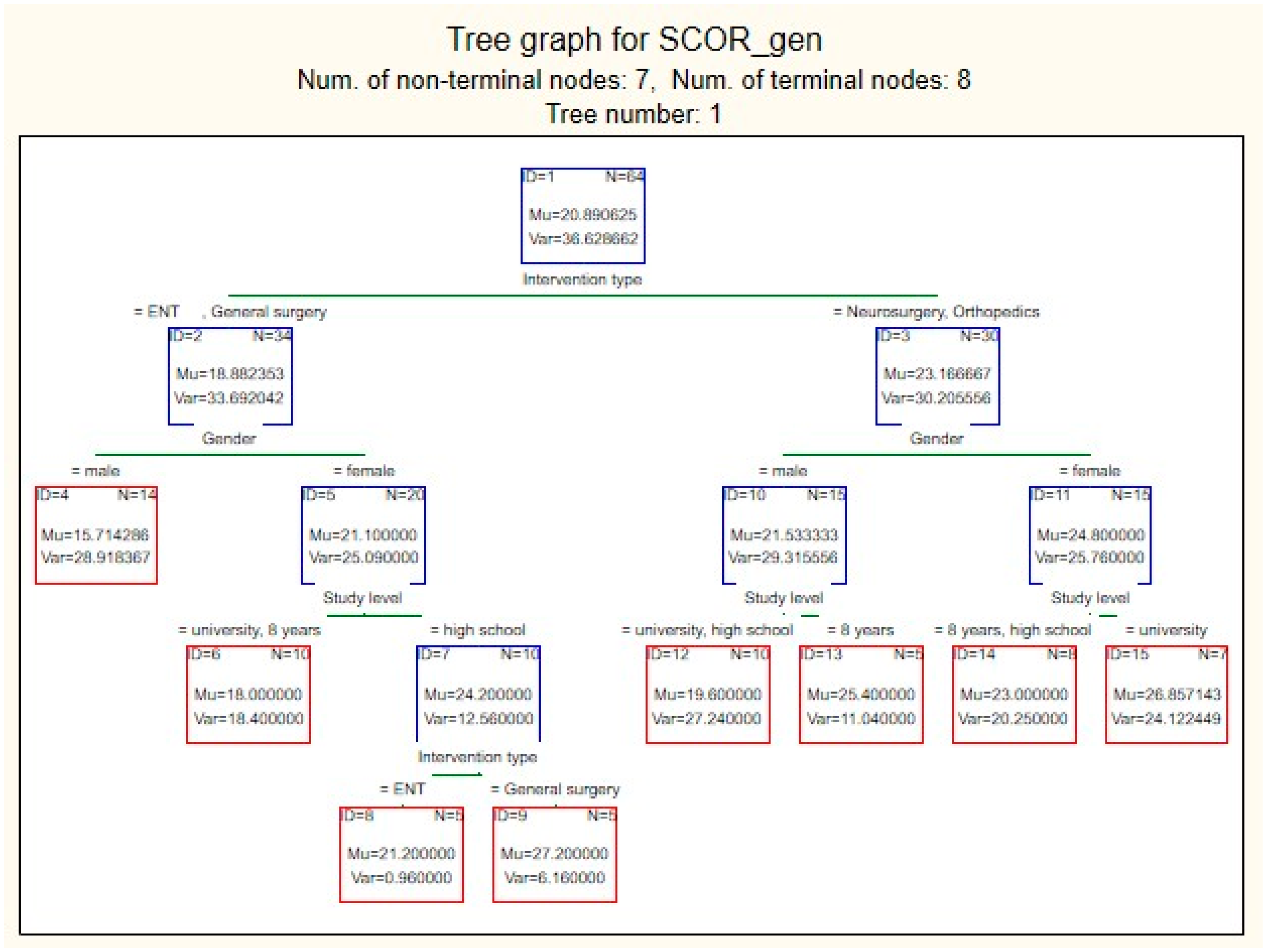
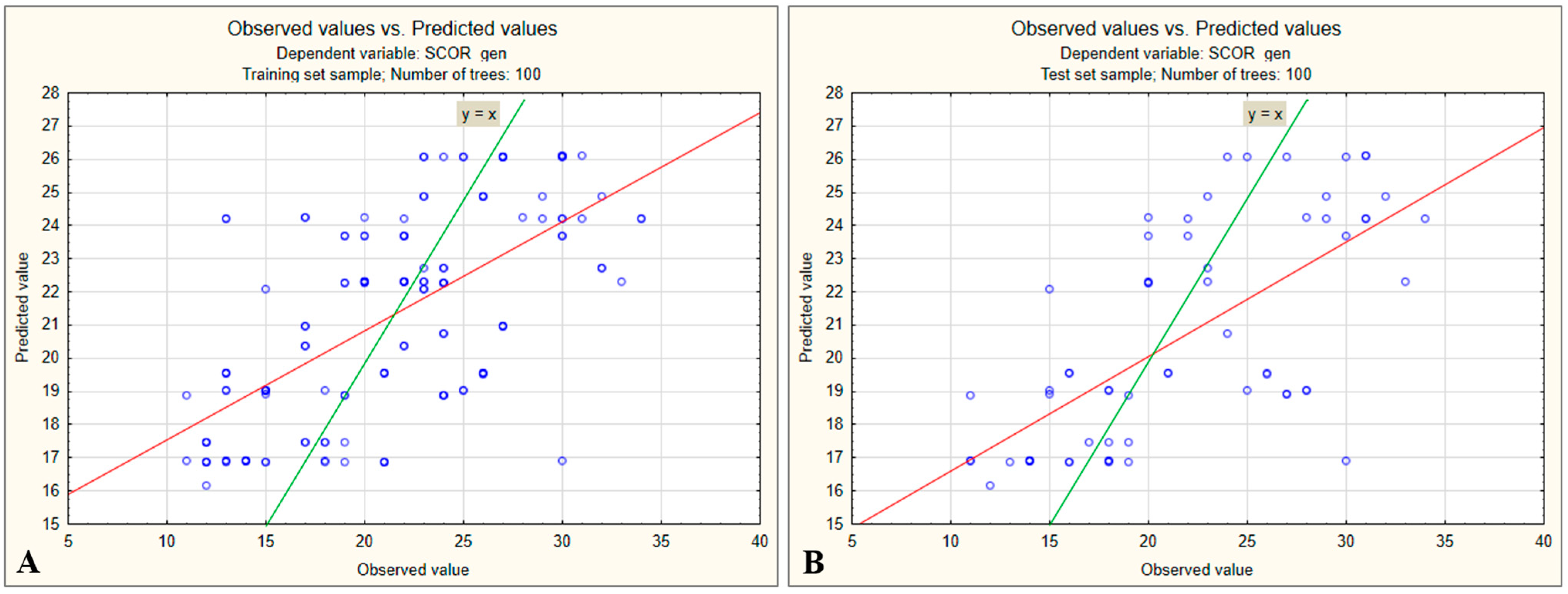
| Variables | N (%) | Variables | N (%) | Variables | N (%) |
|---|---|---|---|---|---|
| Gender | Marital status | Chronic medication | |||
| Female | 118 (59.9%) | Married | 128 (65.0%) | Yes | 109 (55.3%) |
| Male | 79 (40.1%) | Unmarried | 45 (22.8%) | No | 88 (44.7%) |
| Widowed | 9 (4.6%) | ||||
| Divorced | 15 (7.6%) | ||||
| Age group | Alcohol consumption | History of surgical interventions | |||
| 18–40 years | 77 (39.1%) | Yes | 47 (23.9%) | Yes | 143 (72.6%) |
| 41–60 years | 58 (29.4%) | No | 150 (76.1%) | No | 54 (27.4%) |
| >60 years | 62 (31.5%) | ||||
| Place of residence | Tobacco use | History of cancer | |||
| Rural | 119 (60.4%) | Yes | 39 (19.8%) | Yes | 20 (10.2%) |
| Urban | 78 (39.6%) | No | 158 (80.2%) | No | 177 (89.8%) |
| Educational level | Chronic diseases | Type of surgical intervention | |||
| Primary school | 41 (20.8%) | Yes | 97 (49.2%) | Orthopedics | 47 (23.9%) |
| High school | 88 (44.7%) | No | 100 (50.8%) | Neurosurgery | 41 (20.8%) |
| University | 68 (34.5%) | General surgery | 56 (28.4%) | ||
| ENT surgery | 53 (26.9%) | ||||
| Item & Original B-MEPS Wording | Not at All | Somewhat | Moderately | Very Much So | Total | |
| Item 1: I am jittery | 26 (13.2) | 30 (15.2) | 65 (33.0) | 76 (38.6) | 197 (100.0) | |
| Item 2: I feel indecisive | 61 (31.0) | 34 (17.3) | 64 (32.5) | 38 (19.3) | 197 (100.0) | |
| Item 3: I feel worried | 39 (19.8) | 33 (16.8) | 47 (23.9) | 78 (39.6) | 197 (100.0) | |
| Item 4: I feel confused | 66 (33.5) | 53 (26.9) | 39 (19.8) | 39 (19.8) | 197 (100.0) | |
| Item & Original B-MEPS Wording | Almost never | Often | Almost always | Total | ||
| Item 5: I feel like a failure | 128 (65.0) | 47 (23.9) | 22 (11.2) | 197 (100.0) | ||
| Item 6: I worry too much over something that really doesn’t matter | 53 (26.9) | 83 (42.1) | 61 (31.0) | 197 (100.0) | ||
| Item 7: I take disappointments so personally that I can’t get them out of my mind | 71 (36.0) | 82 (41.6) | 44 (22.3) | 197 (100.0) | ||
| Item 8: I get in a state of tension or turmoil as I think over my recent concerns and interests | 81 (41.1) | 81 (41.1) | 35 (17.8) | 197 (100.0) | ||
| Item & Original B-MEPS Wording | No | Yes | Total | |||
| Item 9: Do you feel unhappy? | 151 (76.6) | 46 (23.4) | 197 (100.0) | |||
| Item 10: Do you have a feelings of discomfort in the stomach? | 96 (48.7) | 101 (51.3) | 197 (100.0) | |||
| Item & Original B-MEPS Wording | I may look dispirited but I brighten up easily | I have pervasive feelings of sadness or feel constantly gloomy | Total | |||
| Item 11: How do you react when you are unhappy? | 138 (70.1) | 59 (29.9) | 197 (100.0) | |||
| Item & Original B-MEPS Wording | Occasional sadness | External factors can change it | Being without help or hope | Total | ||
| Item 12: How do you describe your depressed mood? | 68 (34.5) | 105 (53.3) | 24 (12.2) | 197 (100.0) | ||
| Variable/Category | N | Mean | SD | Min | Max | Median | IQR | p-Value |
|---|---|---|---|---|---|---|---|---|
| Total | 197 | 21.42 | 6.047 | 11 | 34 | 21.00 | 17.00–26.00 | |
| Sex | <0.001 †** | |||||||
| Male | 79 | 18.47 | 5.560 | 11 | 32 | 18.00 | 14.00–23.00 | |
| Female | 118 | 23.39 | 5.555 | 13 | 34 | 23.00 | 20.00–28.00 | |
| Age group | 0.883 ‡ | |||||||
| 18–40 years | 77 | 21.36 | 6.438 | 11 | 34 | 21.00 | 15.00–26.00 | |
| 41–60 years | 58 | 21.76 | 5.430 | 11 | 33 | 21.00 | 18.00–24.50 | |
| >60 years | 62 | 21.16 | 6.176 | 12 | 32 | 22.00 | 15.00–27.00 | |
| Place of residence | 0.407 † | |||||||
| Rural | 119 | 21.74 | 6.301 | 11 | 34 | 22.00 | 18.00–26.00 | |
| Urban | 78 | 20.92 | 5.643 | 11 | 30 | 20.00 | 16.00–27.00 | |
| Educational level | 0.003 ‡** | |||||||
| Primary school | 41 | 24.07 | 4.735 | 15 | 32 | 24.00 | 22.00–27.00 | |
| High school | 88 | 20.82 | 6.164 | 11 | 33 | 20.00 | 15.25–26.50 | |
| University | 68 | 20.59 | 6.228 | 12 | 34 | 19.50 | 15.25–25.00 | |
| Marital status | 0.007 ‡** | |||||||
| Married | 128 | 20.95 | 6.419 | 11 | 34 | 21.00 | 15.00–26.00 | |
| Unmarried | 45 | 21.87 | 5.413 | 14 | 32 | 21.00 | 18.00–25.00 | |
| Widowed | 9 | 18.56 | 2.128 | 17 | 22 | 17.00 | 17.00–20.50 | |
| Divorced | 15 | 25.80 | 3.877 | 20 | 30 | 27.00 | 22.00–29.00 | |
| Alcohol consumption | 0.542 † | |||||||
| Yes | 47 | 21.91 | 6.331 | 12 | 32 | 22.00 | 17.00–27.00 | |
| No | 150 | 21.26 | 5.969 | 11 | 34 | 21.00 | 16.75–26.00 | |
| Tobacco use | 0.844 † | |||||||
| Yes | 39 | 21.13 | 6.783 | 11 | 32 | 21.00 | 14.00–27.00 | |
| No | 158 | 21.49 | 5.873 | 11 | 34 | 21.00 | 17.00–26.00 | |
| Chronic diseases | 0.584 † | |||||||
| Yes | 97 | 21.60 | 5.662 | 12 | 33 | 22.00 | 17.00–27.00 | |
| No | 100 | 21.24 | 6.423 | 11 | 34 | 21.00 | 16.50–25.00 | |
| Chronic medication | 0.211 † | |||||||
| Yes | 109 | 21.81 | 5.289 | 12 | 33 | 22.00 | 17.00–26.00 | |
| No | 88 | 20.93 | 6.873 | 11 | 34 | 20.50 | 15.00–26.00 | |
| Previous surgery | 0.614 † | |||||||
| Yes | 143 | 21.27 | 6.129 | 11 | 34 | 21.00 | 15.00–26.00 | |
| No | 54 | 21.81 | 5.863 | 11 | 31 | 21.50 | 18.00–27.00 | |
| History of cancer | 0.002 †** | |||||||
| Yes | 20 | 25.30 | 4.414 | 17 | 30 | 26.00 | 24.00–29.75 | |
| No | 177 | 20.98 | 6.059 | 11 | 34 | 21.00 | 16.00–25.00 | |
| Type of surgery | 0.003 ‡** | |||||||
| Orthopedics | 47 | 24.26 | 5.825 | 13 | 34 | 23.00 | 20.00–30.00 | |
| Neurosurgery | 41 | 21.27 | 5.422 | 11 | 31 | 20.00 | 18.00–24.00 | |
| General surgery | 56 | 20.77 | 6.830 | 11 | 32 | 20.50 | 14.00–27.00 | |
| ENT surgery | 53 | 19.70 | 5.010 | 12 | 33 | 20.00 | 15.00–22.50 |
| Source | Type I Sum of Squares | df | Mean Square | F | Sig. | Partial Eta Squared | Effect Interpretation |
|---|---|---|---|---|---|---|---|
| Type of surgery | 559.731 | 3 | 186.577 | 14.278 | <0.001 ** | 0.224 | High |
| Sex | 1081.645 | 1 | 1081.645 | 82.773 | <0.001 ** | 0.359 | High |
| Educational level | 394.624 | 2 | 197.312 | 15.099 | <0.001 ** | 0.169 | High |
| Marital status | 173.017 | 3 | 57.672 | 4.413 | 0.005 ** | 0.082 | Moderate |
| History of cancer | 415.606 | 1 | 415.606 | 31.804 | <0.001 ** | 0.177 | High |
| Type of surgery × Sex | 286.809 | 3 | 95.603 | 7.316 | <0.001 ** | 0.129 | Moderate |
| Type of surgery × Educational level | 542.103 | 6 | 90.351 | 6.914 | <0.001 ** | 0.219 | High |
| Type of surgery × Marital status | 363.262 | 7 | 51.895 | 3.971 | <0.001 ** | 0.158 | Moderate |
| Type of surgery × History of cancer | 149.052 | 2 | 74.526 | 5.703 | 0.004 ** | 0.072 | Moderate |
| Sex × Educational level | 162.899 | 2 | 81.450 | 6.233 | 0.003 ** | 0.078 | Moderate |
| Educational level × Marital status | 251.631 | 4 | 62.908 | 4.814 | 0.001 ** | 0.115 | Moderate |
| Educational level × History of cancer | 451.934 | 2 | 225.967 | 17.292 | <0.001 ** | 0.189 | High |
| Type of surgery × Sex × Educational level | 143.869 | 4 | 35.967 | 2.752 | 0.030 * | 0.069 | Moderate |
| Type of surgery × Sex × Marital status | 68.112 | 2 | 34.056 | 2.606 | 0.077 + | 0.034 | Low |
| Type of surgery × Educational level × Marital status | 138.192 | 3 | 46.064 | 3.525 | 0.017 * | 0.067 | Moderate |
Disclaimer/Publisher’s Note: The statements, opinions and data contained in all publications are solely those of the individual author(s) and contributor(s) and not of MDPI and/or the editor(s). MDPI and/or the editor(s) disclaim responsibility for any injury to people or property resulting from any ideas, methods, instructions or products referred to in the content. |
© 2025 by the authors. Licensee MDPI, Basel, Switzerland. This article is an open access article distributed under the terms and conditions of the Creative Commons Attribution (CC BY) license (https://creativecommons.org/licenses/by/4.0/).
Share and Cite
Dascălu, C.G.; Cucu, A.I.; Vovciuc, A.; Axinte, S.; Turliuc, S.; Bobu, A.M.; Tamas, C.; Porumb, V.; Patrascanu, E.; Buzduga, C.M.; et al. Decoding Fear: Analysis and Prognosis of Preoperatory Stress Level Through Advanced Statistical Modelling—A Prospective Study Across Multiple Surgical Specialties. Med. Sci. 2025, 13, 181. https://doi.org/10.3390/medsci13030181
Dascălu CG, Cucu AI, Vovciuc A, Axinte S, Turliuc S, Bobu AM, Tamas C, Porumb V, Patrascanu E, Buzduga CM, et al. Decoding Fear: Analysis and Prognosis of Preoperatory Stress Level Through Advanced Statistical Modelling—A Prospective Study Across Multiple Surgical Specialties. Medical Sciences. 2025; 13(3):181. https://doi.org/10.3390/medsci13030181
Chicago/Turabian StyleDascălu, Cristina Gena, Andrei Ionut Cucu, Andreea Vovciuc, Sorin Axinte, Serban Turliuc, Amelian Madalin Bobu, Camelia Tamas, Vlad Porumb, Emilia Patrascanu, Catalin Mihai Buzduga, and et al. 2025. "Decoding Fear: Analysis and Prognosis of Preoperatory Stress Level Through Advanced Statistical Modelling—A Prospective Study Across Multiple Surgical Specialties" Medical Sciences 13, no. 3: 181. https://doi.org/10.3390/medsci13030181
APA StyleDascălu, C. G., Cucu, A. I., Vovciuc, A., Axinte, S., Turliuc, S., Bobu, A. M., Tamas, C., Porumb, V., Patrascanu, E., Buzduga, C. M., Blanaru, P. A., Morosan, A. P., Prutianu, I., Covali, R., Pruteanu, A. I., Costea, C. F., & Carauleanu, A. (2025). Decoding Fear: Analysis and Prognosis of Preoperatory Stress Level Through Advanced Statistical Modelling—A Prospective Study Across Multiple Surgical Specialties. Medical Sciences, 13(3), 181. https://doi.org/10.3390/medsci13030181






